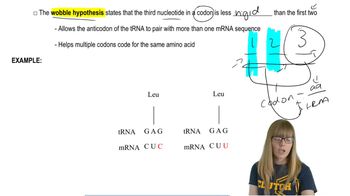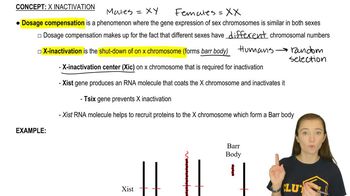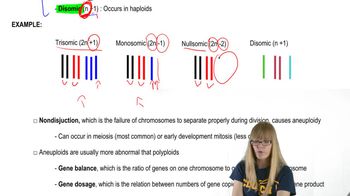Table of contents
- 1. Introduction to Genetics51m
- 2. Mendel's Laws of Inheritance3h 37m
- 3. Extensions to Mendelian Inheritance2h 41m
- 4. Genetic Mapping and Linkage2h 28m
- 5. Genetics of Bacteria and Viruses1h 21m
- 6. Chromosomal Variation1h 48m
- 7. DNA and Chromosome Structure56m
- 8. DNA Replication1h 10m
- 9. Mitosis and Meiosis1h 34m
- 10. Transcription1h 0m
- 11. Translation58m
- 12. Gene Regulation in Prokaryotes1h 19m
- 13. Gene Regulation in Eukaryotes44m
- 14. Genetic Control of Development44m
- 15. Genomes and Genomics1h 50m
- 16. Transposable Elements47m
- 17. Mutation, Repair, and Recombination1h 6m
- 18. Molecular Genetic Tools19m
- 19. Cancer Genetics29m
- 20. Quantitative Genetics1h 26m
- 21. Population Genetics50m
- 22. Evolutionary Genetics29m
6. Chromosomal Variation
Chromosomal Mutations: Aneuploidy
Problem 18b
Textbook Question
Can the Lyon hypothesis be tested in a human female who is homozygous for one allele of the X-linked G6PD gene? Why, or why not?
 Verified step by step guidance
Verified step by step guidance1
Understand the Lyon hypothesis: It states that in females, one of the two X chromosomes is randomly inactivated in each cell, leading to a mosaic of two cell populations, each expressing genes from only one of the X chromosomes.
Consider the genetic condition: A human female who is homozygous for one allele of the X-linked G6PD gene means she has the same allele on both of her X chromosomes.
Analyze the implications: Since both X chromosomes carry the same allele, inactivation of one X chromosome will not result in a phenotypic difference between cells, as both express the same G6PD allele.
Evaluate the testability: The Lyon hypothesis involves observing differences in gene expression between cells with different active X chromosomes. In a homozygous individual, such differences cannot be observed because both alleles are identical.
Conclude: Therefore, the Lyon hypothesis cannot be effectively tested in a human female who is homozygous for one allele of the X-linked G6PD gene, as there is no variation in the expressed allele to observe.
Recommended similar problem, with video answer:
 Verified Solution
Verified SolutionThis video solution was recommended by our tutors as helpful for the problem above
Video duration:
2mPlay a video:
Was this helpful?
Key Concepts
Here are the essential concepts you must grasp in order to answer the question correctly.
Lyon Hypothesis
The Lyon hypothesis, proposed by Mary Lyon in 1961, states that in female mammals, one of the two X chromosomes is randomly inactivated during early embryonic development. This process, known as X-inactivation, ensures dosage compensation between males (XY) and females (XX) for X-linked genes. The inactivated X chromosome forms a Barr body and is largely transcriptionally silent, which can affect the expression of X-linked traits.
Recommended video:
Guided course

Translation:Wobble Hypothesis
X-linked Inheritance
X-linked inheritance refers to the pattern of inheritance for genes located on the X chromosome. In females, who have two X chromosomes, the effects of X-linked alleles can be masked by the presence of a second allele. In contrast, males, having only one X chromosome, express whatever allele is present, making X-linked traits more apparent in males. This is crucial for understanding how traits like G6PD deficiency are inherited and expressed.
Recommended video:
Guided course

X-Inactivation
Homozygosity in X-linked Genes
Homozygosity in the context of X-linked genes occurs when an individual has two identical alleles for a gene located on the X chromosome. In a human female who is homozygous for one allele of the G6PD gene, both X chromosomes carry the same allele, meaning that X-inactivation would not affect the expression of the G6PD gene. Therefore, testing the Lyon hypothesis in this scenario is not feasible, as there would be no variability in expression to observe.
Recommended video:
Guided course

Sex-Linked Genes
Related Videos
Related Practice




